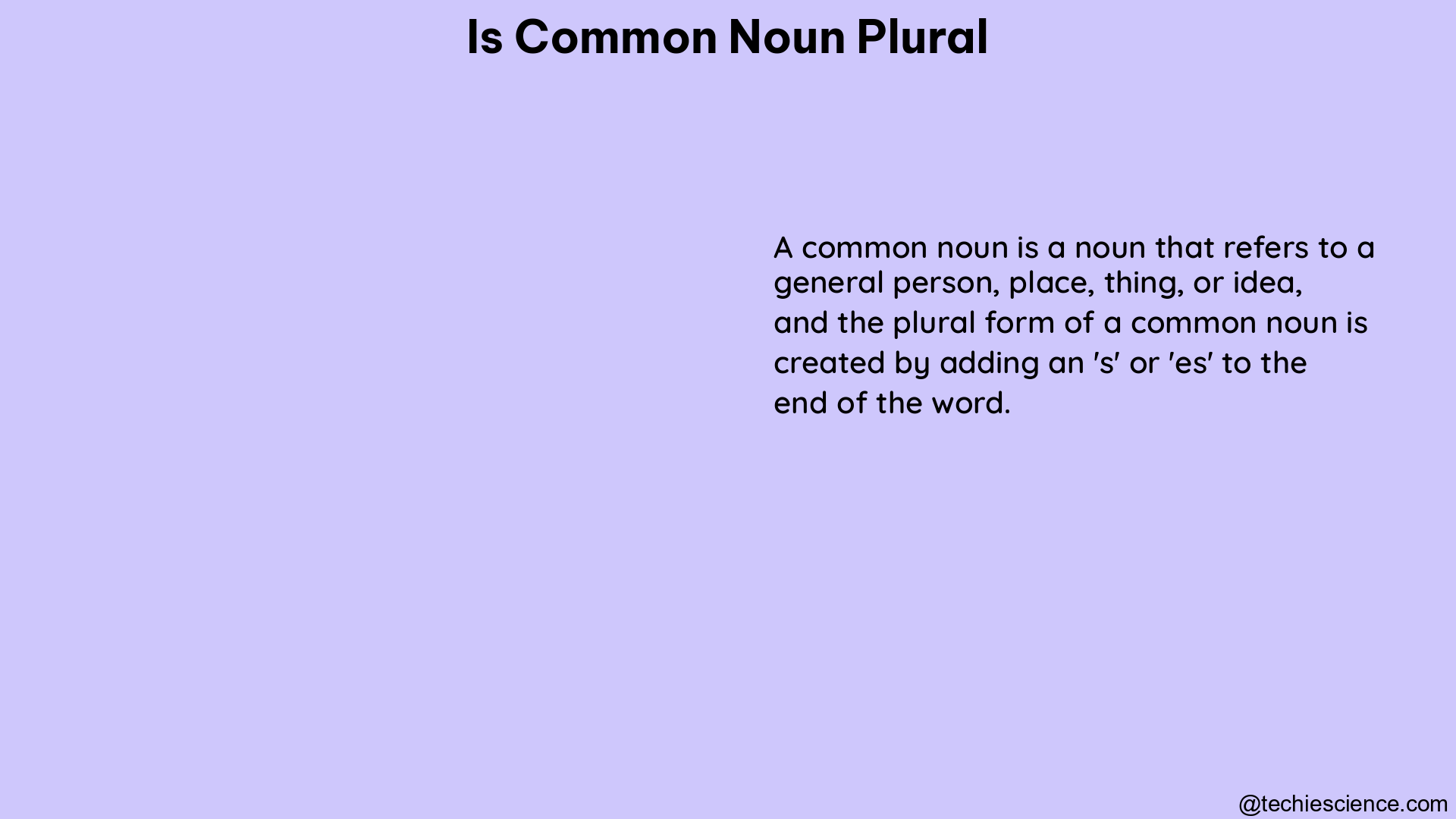Mastering the art of pluralizing common nouns is a crucial aspect of English grammar. Whether you’re a student, a writer, or simply someone who wants to communicate effectively, understanding the rules and exceptions for forming plural common nouns is essential. In this comprehensive guide, we’ll delve into the intricacies of pluralizing common nouns, providing you with a thorough understanding of the topic.
Understanding Common Nouns
Before we dive into the specifics of pluralizing common nouns, let’s first establish a clear understanding of what a common noun is. A common noun is a word that names a general person, place, thing, or idea, as opposed to a proper noun, which names a specific person, place, or thing.
Examples of common nouns include:
- Person: woman, man, child
- Place: city, country, park
- Thing: book, car, apple
- Idea: love, happiness, freedom
Common nouns are not capitalized unless they appear at the beginning of a sentence or in a title.
Pluralizing Common Nouns: The Basic Rules

The most common way to form the plural of a common noun is by adding an ‘s’ to the end of the word. However, there are several other rules and exceptions to consider when pluralizing common nouns. Let’s explore the primary rules:
1. Adding ‘s’
This is the most straightforward rule for pluralizing common nouns. Simply add an ‘s’ to the end of the word to make it plural.
Examples:
– Singular: book, dog, chair
– Plural: books, dogs, chairs
2. Adding ‘es’
For common nouns that end in ‘o’, ‘ch’, ‘sh’, ‘ss’, or ‘x’, add ‘es’ to form the plural.
Examples:
– Singular: potato, church, dish, glass, box
– Plural: potatoes, churches, dishes, glasses, boxes
3. Changing ‘y’ to ‘ies’
If a common noun ends in a consonant followed by ‘y’, change the ‘y’ to ‘ies’ to form the plural.
Examples:
– Singular: baby, city, country
– Plural: babies, cities, countries
4. Changing ‘f’ or ‘fe’ to ‘ves’
For common nouns that end in ‘f’ or ‘fe’, change the ending to ‘ves’ to create the plural form.
Examples:
– Singular: leaf, knife, life
– Plural: leaves, knives, lives
Irregular Plural Common Nouns
While the basic rules cover the majority of common nouns, there are some irregular plural forms that don’t follow the standard patterns. These irregular plurals must be memorized, as they don’t follow a consistent pattern.
Examples of irregular plural common nouns:
– Singular: man, woman, child, mouse, tooth
– Plural: men, women, children, mice, teeth
Collective Nouns and Pluralization
Collective nouns, which refer to a group of individuals or things, can present a unique challenge when it comes to pluralization. Depending on the context, collective nouns can be treated as either singular or plural.
Examples of collective nouns:
– Singular: team, family, herd
– Plural: teams, families, herds
When using a collective noun, the verb form should match the intended meaning. If the collective noun is referring to the group as a whole, the verb should be singular. If the collective noun is referring to the individual members of the group, the verb should be plural.
Examples:
– The team is practicing for the game. (Singular verb)
– The team are arguing among themselves. (Plural verb)
Hyphenated Nouns and Pluralization
When dealing with hyphenated nouns, the plural form is typically created by adding the plural ending to the main noun.
Examples:
– Singular: mother-in-law, attorney-at-law
– Plural: mothers-in-law, attorneys-at-law
Subject-Verb Agreement with Plural Common Nouns
When using plural common nouns in a sentence, it’s important to ensure that the verb form agrees with the plural subject. The verb should be in the plural form to match the plural noun.
Examples:
– Singular: The dog runs.
– Plural: The dogs run.
Uncountable and Abstract Nouns
Not all nouns can be pluralized. Uncountable nouns, such as water, sand, or information, and abstract nouns, such as love, happiness, or courage, do not have a plural form.
Examples:
– Singular: water, sand, information, love, happiness, courage
– No plural form
Practicing Pluralizing Common Nouns
To solidify your understanding of pluralizing common nouns, it’s essential to practice applying the rules and identifying irregular forms. Here are some exercises you can try:
- Pluralize the following common nouns:
- Book
- Potato
- City
- Leaf
- Mouse
-
Team
-
Identify the correct verb form to match the plural common noun:
- The children (play/plays) in the park.
- The families (visit/visits) the museum.
-
The teams (compete/competes) in the tournament.
-
Determine whether the following nouns can be pluralized or not:
- Water
- Happiness
- Chair
- Information
- Love
By practicing these exercises, you’ll develop a deeper understanding of the rules and exceptions for pluralizing common nouns, which will enhance your overall proficiency in English grammar.
Conclusion
Mastering the art of pluralizing common nouns is a crucial step in improving your English language skills. By understanding the basic rules, recognizing irregular forms, and applying subject-verb agreement, you’ll be able to communicate more effectively and accurately. Remember to practice regularly, and don’t hesitate to refer back to this comprehensive guide whenever you need a refresher on pluralizing common nouns.
References
- BYJU’S. (n.d.). Plural Noun – Rules, Types and Examples. Retrieved from https://byjus.com/english/plural-noun/
- English Club. (n.d.). Common Nouns. Retrieved from https://www.englishclub.com/grammar/nouns-common.php
- University of Arkansas. (n.d.). Proper Nouns Common Nouns. Retrieved from https://walton.uark.edu/business-communication-lab/resources/downloads/nouns.pdf
- Edulyte. (n.d.). What is a Common Noun? Definition, Examples & Exercises. Retrieved from https://www.edulyte.com/english/common-noun/

Hi…. I am Goutam Datta. I have completed a double M. A. in English and B. Ed. I am a creative writer. Currently, I am a part of the LambdaGeeks.